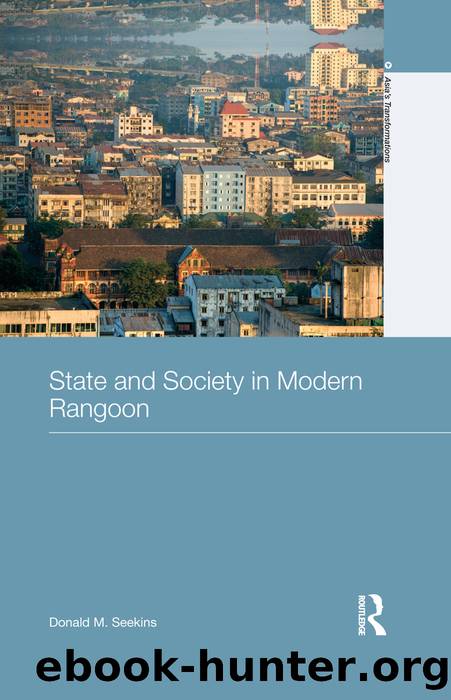State and Society in Modern Rangoon by Donald M. Seekins

Author:Donald M. Seekins [Seekins, Donald M.]
Language: eng
Format: epub
Tags: Ethnic Studies, Social Science, Political Science, Regional Studies, General
ISBN: 9781317601531
Google: ZkjXAwAAQBAJ
Goodreads: 22577877
Publisher: Routledge
Published: 2010-01-01T00:00:00+00:00
Politics in the kitchen: the unrest of 1967 and 1974
The journalist Denzil Peiris noted in 1974, a year when labor strikes broke out at factories in Upper Burma and Rangoon, that â[i]n developing Asia, rice is politics. Movements to overthrow governments begin in the kitchen.â59 As observed in Chapter 5, economic insecurity was a fact of life in socialist Rangoon, since the BSPP found it difficult to procure enough rice through official channels to feed the urban population even when harvests were good. Slow economic growth in real terms (2.5 percent in the mid-1970s) coupled with a rapidly growing population (2.3 percent) meant that standards of living steadily trended downwards.60 Official figures for the consumer price index (CPI) in Rangoon show it rising from a base of 100 in 1965 to 206.4 a decade later, and from 74.07 in 1980 (base of 100 in 1986) to 144.78 in 1988.61 In 1987 alone, the CPI rose 24 percent, according to official figures. Actual inflation rates were probably much higher. In concrete terms, this meant that a pyi (2.13 kilograms) of low-grade rice (known in Burmese as ngasein) purchased in Rangoon cost K2.77 in 1981 but K7.91 in 1988; a longyi made of cotton, K46.14 in 1981 and K110.77 in 1988.62 In most years, people had little disposable income. The money they had was spent mostly on food.
A majority of observers concur that the anti-Chinese riots of June 1967 were pogroms encouraged if not organized by the government to draw the publicâs attention away from severe rice shortages that had caused unrest around the country. In the worst instance of communal violence since the anti-Indian riots of the 1930s, Burmese mobs killed an estimated 50 to 100 Chinese people, mostly in the old Chinatown district located in the western part of downtown, Latha and Lanmadaw Townships (Chinese state media at the time claimed several hundred fatalities).63 Homes and shops were burned and looted, cars set on fire and the Chinese embassy attacked; Burmese intruders got inside the embassy compound on 28 June and killed a Chinese official. Local Karens were attacked by the mobs because, being relatively light-skinned, they were mistaken for Chinese.64 In the weeks that followed, anti-Chinese violence spread throughout the country with many more casualties.
A contributing factor was Mao Zedongâs Great Proletarian Cultural Revolution, which was in its most fanatic phase. Chinese embassies worldwide zealously promoted the Maoist cult, often to the bemusement of locals. In Rangoon, embassy officials distributed Mao badges, red armbands and Little Red Books (The Quotations of Chairman Mao Zedong) to students at formerly Chinese primary and secondary schools that had been nationalized and were obliged to follow a Burmese curriculum, but still had mostly Chinese enrollments.65 The education ministry banned cultural revolution-style activities (especially the wearing of Mao badges), which made some Chinese students indignant. On 26 June, school principals were required to explain the ban to their students, who at one school protested and confined their principal to his office. Soldiers were sent to rescue him and break up the protests.
Download
This site does not store any files on its server. We only index and link to content provided by other sites. Please contact the content providers to delete copyright contents if any and email us, we'll remove relevant links or contents immediately.
Machine Learning at Scale with H2O by Gregory Keys | David Whiting(4032)
Harry Potter and the Goblet Of Fire by J.K. Rowling(3753)
Never by Ken Follett(3739)
Unfinished: A Memoir by Priyanka Chopra Jonas(3290)
Fairy Tale by Stephen King(3178)
The Man Who Died Twice by Richard Osman(2969)
Will by Will Smith(2754)
Rationality by Steven Pinker(2246)
The Dark Hours by Michael Connelly(2202)
It Starts With Us (It Ends with Us #2) by Colleen Hoover(2164)
The Storyteller by Dave Grohl(2146)
Can't Hurt Me: Master Your Mind and Defy the Odds - Clean Edition by David Goggins(2106)
The Dawn of Everything: A New History of Humanity by David Graeber & David Wengrow(2099)
Friends, Lovers, and the Big Terrible Thing by Matthew Perry(2094)
The Becoming by Nora Roberts(2050)
The Stranger in the Lifeboat by Mitch Albom(2023)
Cloud Cuckoo Land by Anthony Doerr(2009)
Love on the Brain by Ali Hazelwood(1926)
Einstein: His Life and Universe by Walter Isaacson(1924)
